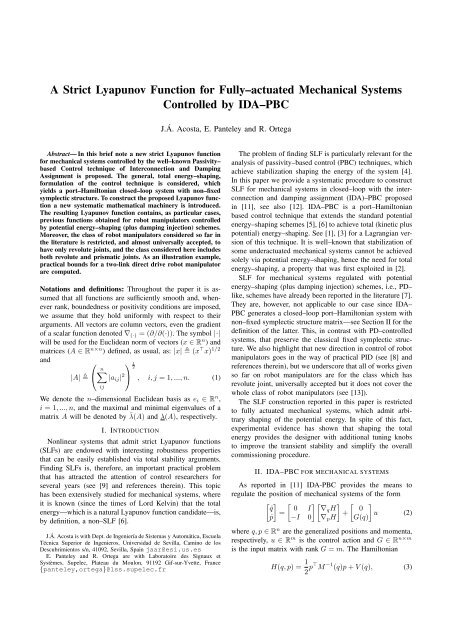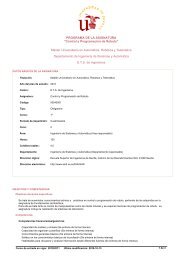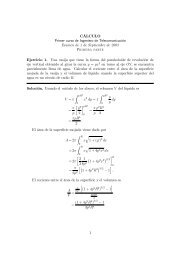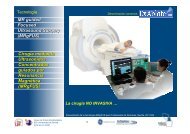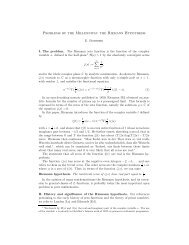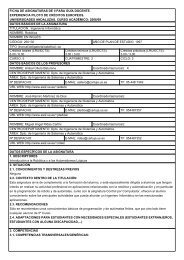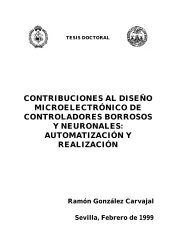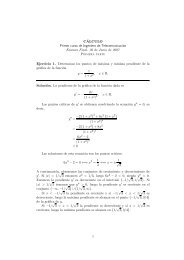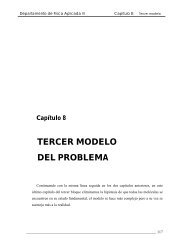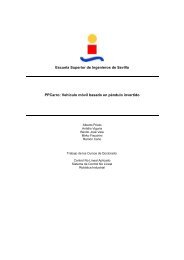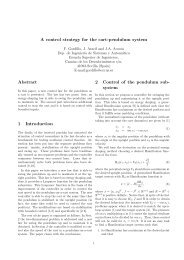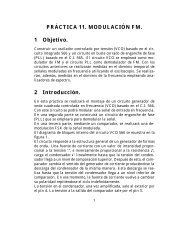A Strict Lyapunov Function for Fully-actuated Mechanical Systems ...
A Strict Lyapunov Function for Fully-actuated Mechanical Systems ...
A Strict Lyapunov Function for Fully-actuated Mechanical Systems ...
You also want an ePaper? Increase the reach of your titles
YUMPU automatically turns print PDFs into web optimized ePapers that Google loves.
CONFIDENTIAL. Limited circulation. For review only.IV. PROOF OF PROPOSITION 1A. The cross–term W 0 (q, p)The cross–term, which generates a critical negative termin |∇V d | 2 , has been motivated by the construction given in[9].The derivative of W 0 (q, p) along the trajectories of (7)yieldsẆ 0 = ∇ q W0 ⊤ ˙q + ∇ p W0 ⊤ ṗ= [ ∇ 2 pqH d ∇V d + ∇ 2 qV d ∇ p Hd ] ⊤˙q+ [ ∇ 2 ] ⊤pH d ∇V d ṗ= [ ∇Vd ⊤ ∇ 2 pqHd⊤ + ∇ p Hd ⊤ ∇ 2 qVd⊤ ]× (M −1 M d ∇ p H d )+ [ ∇Vd ⊤ ∇ 2 ]pH d× (−M d M −1 ∇ q H d +(J 2 − R 2 )∇ p H d )= ∇Vd ⊤ ∇ 2 pqHd ⊤ M −1 M d ∇ p H d+ ∇ p Hd ⊤ ∇ 2 qVd ⊤ M −1 M d ∇ p H d− ∇Vd ⊤ ∇ 2 pH d M d M −1 ∇ q H d+ ∇Vd ⊤ ∇ 2 pH d (J 2 − R 2 )∇ p H d . (11)Some calculations are now in order,∇ q H d = 1 2 ∇ q(p ⊤ M −1dp)+∇V d∇ 2 pV d = ∇ 2 pVd⊤∇ p H d = M −1dp∇ 2 pH d = M −1d∇ 2 pqH d = ∇ q (∇ p H d )=∇ q (M −1d p)∇ q (p ⊤ M −1d p) = ∇ q(M −1dp)⊤ p= ∇ q (M −1dp)⊤ M d ∇ p H dReplacing these equalities in (11) yieldsẆ 0 = ∇Vd ⊤ ∇ q (M −1dp)⊤ M −1 M d ∇ p H d+ ∇ p Hd ⊤ ∇ 2 qV d M −1 M d ∇ p H d−1 2 ∇V d ⊤ M −1 ∇ q (M −1 p)⊤ M d ∇ p H d+ ∇V ⊤−d M −1dd(J 2 − R 2 )∇ p H d∇Vd ⊤ M −1 ∇V d , (12)and we attract your attention to the last negative term.B. Term α(H d ) to achieve properness and positivityIn this subsection we construct a K ∞ function α, thatadded to the cross–term defined above, yields a positivedefinite function.Towards this end, note that in view of Assumption 1 and2 there exists α, α ∈K ∞ such thatα(|(q, p)|) ≤ H d (q, p) ≤ α(|(q, p)|). (13)Using these bounds, Assumption 3 and the fact that|∇ p H d | = |M −1 p|, we can bound the cross term asd|W 0 | ≤ |∇ p Hd ⊤ ∇V d |≤ (m d + k d (|q|))|p|·k 1 (|q|)≤ (m d + k d (|(q, p)|)) ·|(q, p)|·k 1 (|(q, p)|)≤ ¯k(|(q, p)|), (14)<strong>for</strong> some ¯k ∈K ∞ .Define α(s) ¯k ◦ α −1 (s), thenα(H d )+W 0 ≥ α ◦ α(|(q, p)|) − ¯k(|(q, p)|)= ¯k ◦ α −1 ◦ α(|(q, p)|) − ¯k(|(q, p)|)= ¯k(|(q, p)|) − ¯k(|(q, p)|) =0,proving that composite function α(H d )+W 0 is radiallyunbounded (proper) and positive definite.C. Bound <strong>for</strong> |Ẇ0|Now we bound all terms from the derivative of the crossterm (11) with indefinite sign. For, notice that∇ q (M −1dp) ij = e ⊤ i∂M −1d∂q jp, i, j =1, ..., n (15)and. Thus, from definition (1) and Assumption 4 a bound <strong>for</strong>(15) reads∣∣∇ q (M −1dp) ij∣≤∂M −1∣ e⊤ di p∂q j∣≤∣ ∣e ⊤ ∣i ·∂M −1∣ d ∣∣∣∣ p∂q j∣ = ∂M −1dp∂q j∣≤∂M −1 ∣d ∣∣∣∣ ·|p|∂q j≤ γ(|q|) ·|p| (16)Now, with the previous bounds and (16) it is straight<strong>for</strong>wardto bound each term of |Ẇ0| from (12). Thus, we get|∇Vd ⊤ ∇ q (M −1d p)⊤ M −1 M d ∇ p H d |≤ |∇V d ||∇ q (M −1d p)||M −1 ||p| ≤γ 1 (|q|)|p| 2|∇ p Hd ⊤ ∇ 2 qV d M −1 M d ∇ p H d |≤ |∇ p H d ||∇ 2 qV d ||M −1 ||p| ≤γ 2 (|q|)|p| 2≤≤≤| 1 2 ∇V d ⊤ M −1 ∇ q (M −1d p)⊤ M d ∇ p H d |12 |∇V d||M −1 ||∇ q (M −1d p)||p| ≤γ 3(|q|)|p| 2|∇Vd ⊤ M −1d J 2∇ p H d ||∇V d ||M −1d||J 2||M −1d ||p| ≤γ 4(|q|)|p| 2|∇Vd ⊤ M −1d R 2∇ p H d ||∇V d ||M −1d||R 2||M −1d||p| ≤γ 5(|q|)|∇V d ||p|,Preprint submitted to 2009 IEEE Multi-conference on <strong>Systems</strong> and Control.Received January 21, 2009.
CONFIDENTIAL. Limited circulation. For review only.where γ i ∈K ∞ , <strong>for</strong> i =1, ..., 5. Denoting by γ 1→5 (|q|) thebound <strong>for</strong> the sum of all γ i , the bound becomes|Ẇ0| ≤ −m|∇V d | 2 + γ 5 (|q|)|∇V d ||p| + γ 1→5 (|q|)|p| 2≤ −m|∇V d | 2 + m 2 |∇V d| 2 + 12m γ 5(|q|) 2 |p| 2+ γ 1→5 (|q|)|p| 2= − m ( )12 |∇V d| 2 +2m γ 5(|q|) 2 + γ 1→5 (|q|) |p| 2≤ − m 2 |∇V d| 2 +¯γ(|q|)|p| 2 ,with ¯γ(|q|) ∈K ∞ . Additionally note that since ¯γ ∈K ∞ wecan find a constant m 0 and a function ¯γ 1 ∈K ∞ such that¯γ(|q|) ≤ m 0 +¯γ 1 (|(q, p)|). (17)D. The terms W 1 (q, p) and W 2 (q, p) to complete the SLFWe now construct the term W 1 to dominate the constantterm m 0 in (17). Since from equation (8) Ḣ d ≤−h d |p| 2 ,then from the Assumption 1 h d = λ(R 2 )m 2 d . We choose W 1as in (10) withc (1 + ρ m 0) m 0h d, (18)<strong>for</strong> some constant ρ>0.The last term of the construction, W 2 (q, p) is needed todominate the term ¯γ 1 (|(q, p)|) in (17). For, we choose W 2as in (10) withβ(s) 1 ∫ s(¯γ 1 ◦ α −1 )(τ)dτ. (19)h d0Since ¯γ 1 ∈K ∞ , we also have β ∈K ∞ . The derivative ofW 2 can be bounded asẆ 2 = 1 h d¯γ 1 ◦ α −1 (H d ) · Ḣ d ,≤ −¯γ 1 ◦ α −1 (H d ) ·|p| 2≤ −¯γ 1 ◦ α −1 (α) ·|p| 2≤ −¯γ 1 (|(q, p)|) ·|p| 2E. Verifying the conditions <strong>for</strong> a SLFWe now check that V verifies all conditions from thedefinition of a SLF in 1. From Subsection IV-B we knowthat α(H d )+W 0 is positive definite. Since by constructionthe remaining terms W 1,2 are proper and positive definitethemselves, then their sum (9) is positive definite and radiallyunbounded.From the previous derivations the derivative of V alongthe trajectories of the system (7) reads˙V =≤˙̂α(H d )+2∑i=0Ẇ i− ∂α∣ h d |p| 2∂s s=Hd(⇐ ˙̂α(Hd ))− m 2 |∇V d| 2 +¯γ(|q|) |p| 2 (⇐ Ẇ0)−(1 + ρ m 0)m 0 |p| 2 (⇐ Ẇ1)−¯γ 1 (|(q, p)|) |p| 2 (⇐(Ẇ2)= − ρ + ∂α)∣ h d |p| 2 − m ∂s s=Hd 2 |∇V d| 2≤ −ρ|p| 2 − m 2 |∇V d| 2 ,where, to obtain the second identity we used the bound (17)while the last inequality follows from the fact that∂α∣ > 0,∂s s=Hdbecause the function α ∈K ∞ . From the last inequality andAssumption 2 we conclude that − ˙V is a positive definitefunction, completing the proof.V. AN EXAMPLE: DIRECT DRIVE 2-LINK ROBOTThe 2-link robot is a robot with two degree of freedommoving on a vertical plane 4 . The control objective is toposition each link, which are both <strong>actuated</strong>, to a desiredposition q = q ∗ , and without loss of generality we chooseq ∗ =0.The inertia matrix reads M(q) =M 0 + M 1 cos q 2 where[ ][ ]c1 cM 0 32 1, and Mc 3 c 1 c 2 ,3 1 0and then inverse yieldsM −1 (q) = 1 [ ]c3 −c 3+ 1 [ ]0 −1c∆ −c 3 c 1 ∆ −1 2 2 cos q 2with ∆=c 1 c 3 − c 2 3 − c 2 2 cos 2 q 2 > 0. On the other hand, thegradient of the open–loop potential function reads[ ]c4 sin q∇V =1 + c 5 sin(q 1 + q 2 ).c 5 sin(q 1 + q 2 )All the above c i with c i , i =1, ..., 5 are positive constants.A. Open–loop boundsThen, according to definition of norm of a matrix andapplying the triangle inequality some calculations are first inorder1) The inertia matrix:• |M 0 | 2 = c 2 1 +3c 2 3 and,• |M 1 | 2 =6c 2 2.2) The determinant, δ ≤ ∆ ≤ δ:• δ c 1 c 3 − c 2 3 − c 2 2 and,• δ c 1 c 3 − c 2 3 + c 2 2.4 See <strong>for</strong> instance [10] and references therein.Preprint submitted to 2009 IEEE Multi-conference on <strong>Systems</strong> and Control.Received January 21, 2009.
CONFIDENTIAL. Limited circulation. For review only.3) Defining the bounds• M ||M 0 |−|M 1 || and,• M |M 0 | + |M 1 |,then from (4) the bounds are m M/δ, m M/δand where κ(|q|) =0.B. Closed–loop boundsWe now calculate all the bounds given in the proposition1, first in the assumptions and then all the bounds needed tocalculate the SLF.Assumption 1. To compare with previous results we selectM d = M and then m d m, m d m and κ d (|q|) =0.Assumptions 2 and 3. We define the desired potentialfunction as V d 1 2 q⊤ q, and then k 1 |q|.Assumption 4. The function γ from (16) can be estimatedas follows∣∂M −1d∂q j∣ ∣∣∣=∣∂M −1∂q j∣ ∣∣∣=∣ −1 ∂M ∣∣∣∣M M −1∂q∣ j∣ ∣∣∣≤ |M −1 | 2 ∂M ∣∣∣∂q j√≤ |M −1 | 2 |M 1 | = m 2 c 2 6Now, we need to calculate all the remaining class K ∞functions1) From (13) the bounds <strong>for</strong> H d are:• α = 1 2 min{1, m d}|(q, p)| 2 and,• α = 1 2 max{1, m d}|(q, p)| 2 .2) Now we have to estimate ¯γ from (17). Thus, straight<strong>for</strong>wardcalculations yield• γ 1 = m 3 d c 2√6 |q|,• γ 2 = m 2 d |q|,• γ 3 = m 3 d c 2√6/2 |q|,• J 2 0 and then γ 4 =0,• R 2 I 2 and( then γ√ 5 = m 2 d |q|,• γ 1→5 = m 2 d 2+3 6c2 m d /2 ) |q|,and then ¯γ b 2 /a + a|q| 2 , wherea m4 d2m and, b m2 d(2+ 3 )√6c2 m d .2Thus, from (17) we select m 0 b 2 /a and ¯γ 1 a|(q, p)| 2 .C. The constructive SLFOnce we have defined all bounds we can define thecomposite SLF from (9).1) α(H d ):• From (14) we get ¯k = m d |(q, p)| 2 and then,• α = ¯k ◦ α −1 = |(q, p)|2m dmin{1,m d }2) W 0 : since M d = M then W 0 = p ⊤ M −1 q.3) W 1 : since <strong>for</strong> simplicity we selected R 2 = I 2 above,which is free <strong>for</strong> the designer then, from (8) and theAssumption 1, h d = m 2 d. Thus, from (18) we calculatec with the previous bounds and, there<strong>for</strong>e W 1 = cH d .4) W 2 : β is defined by (19) and thenW 2 = β(H d )= 1 ∫ Hd(¯γ 1 ◦ α −1 )(τ)dτ,h dwhere ¯γ 1 ◦ α −1 (s) =a min{1, m d }/2 s.Remark 2: We underscore that most of the bounds aredefined in the closed–loop dynamics. This fact allow to thedesigner to reduce drastically the estimation of the bounds.For example, notice that we have chosen M d = M tocompare with previous results but, the estimation of mostof the bounds can be easily computed if we chose M d = I 2instead of M d = M. In this case γ 1 and γ 3 are zero andthere<strong>for</strong>e γ 5 is trivial and just a function of R 2 .VI. CONCLUSIONSA new SLF <strong>for</strong> fully–<strong>actuated</strong> mechanical systems controlledby IDA–PBC has been proposed. Since the totalenergy–shaping version of IDA–PBC is considered, theclosed–loop is a port–Hamiltonian System with non–fixedsymplectic structure, hence the SLF reported in the literature<strong>for</strong> robot manipulators controlled by PD or extended PDactions are not applicable.ACKNOWLEDGEMENTSThe work of J.Á. Acosta was supported by The Consejeríade Innovación, Ciencia y Empresa of The Junta de Andalucíaunder IAC programme, and by The Ministerio de Ciencia eInnovación under grant DPI2006-07338.APPENDIXA PRACTICAL JUSTIFICATION FOR KINETICENERGY–SHAPINGAs it was shown in [5] a PD + gravity compensation isthe simplest way to stabilize a fully–<strong>actuated</strong> mechanicalsystem or a robot manipulator (see also [7]). Thus, bychoosing M d (q) =M(q) in (6) we easily recover the PD +gravity compensator proposed in [5]. In fact, the controller(6) becomesû = G −1 (∇V −∇V d +(J 2 − R 2 )˙q).The latter controller works well even taking into account thelinear friction/damping <strong>for</strong>ces. Otherwise, when drag <strong>for</strong>cesare taken into account the PD + gravity compensator couldnot be enough to reach good per<strong>for</strong>mances stabilizing a robotmanipulator. An alternative way to reach a good responseis using additionally kinetic energy shaping. Let us pose asimple example: suppose a simple robot manipulator withjust 1 link moving inside a flow, in practice it could bethe arm of a horizontal robot manipulator of an underwatervehicle. Thus, if θ is the angular position of the arm, themodel of the rotational motion of this arm is described by¨θ = −c ˙θ − d ˙θ 2 + u,where c>0 is the damping constant of the motor and d>0is the drag constant due to the friction with the water. Forsimplicity suppose that we regulate round θ =0and ˙θ ≥ 0,i.e. u ≥ 0. Then, since no gravity is present then the PD +0Preprint submitted to 2009 IEEE Multi-conference on <strong>Systems</strong> and Control.Received January 21, 2009.


